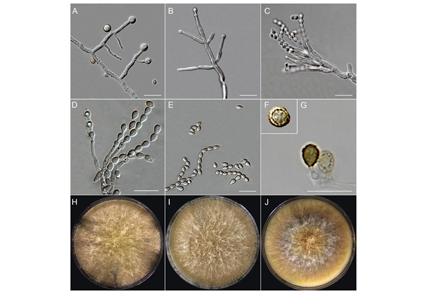Abstract
During a survey of endophytic fungi associated with ornamental plants in the Czech Republic, Paecilomyces-like strains were isolated from the root of Clematis. Analyses based on a combined internal transcribed spacer region (ITS), beta-tubulin (tub2) and calmodulin (CaM) sequence data matrix were applied to infer the phylogenetic position of these isolates. The novel species is characterized by phialides with a cylindrical basal portion tapering to a thin long neck producing pyriform conidia in chains. The new species is introduced with comprehensive descriptions, illustrations and a phylogenetic tree herein. Two primer pairs targeting the partial CaM gene, cm1F/cm1R and cm2F/cm2R, were designed in this study.
References
<p>Beuchat, L.R. & Rice, S.L. (1979) <em>Byssochlamys</em> spp. and processed fruits. <em>Advances in Food Research</em> 25: 237–288.</p>
<p>van den Brule, T., Punt, M., Teertstra, W., Houbraken, J., Wösten, H. & Dijksterhuis, J. (2020) The most heat-resistant conidia observed to date are formed by distinct strains of <em>Paecilomyces variotii</em>. <em>Environmental Microbiology</em> 22: 986–999. https://doi.org/10.1111/1462-2920.14791</p>
<p>Carbone, I. & Kohn, L.M. (1999) A Method for Designing Primer Sets for Speciation Studies in Filamentous <em>Ascomycetes</em>. <em>Mycologia</em> 91: 553–556. https://doi.org/10.2307/3761358</p>
<p>Crous, P.W., Wingfield, M.J., Richardson, D.M., Leroux, J.J., Strasberg, D., Edwards, J., Roets, F., Hubka, V., Taylor, P.W.J., Heykoop, M. & Martín, M.P. (2016) Fungal Planet description sheets: 400-468. <em>Persoonia</em> 36: 316–458. https://doi.org/10.3767/003158516X692185</p>
<p>Glass, N.L. & Donaldson, G.C. (1995) Development of primer sets designed for use with the PCR to amplify conserved genes from filamentous <em>Ascomycetes</em>. <em>Applied and Environmental Microbiology</em> 61: 1323–1330.</p>
<p>Hong, S.B., Cho, H.S., Shin, H.D., Frisvad, J.C. & Samson, R.A. (2006) Novel <em>Neosartorya</em> species isolated from soil in Korea. <em>International journal of systematic and evolutionary microbiology</em> 56: 477–486. https://doi.org/10.1099/ijs.0.63980-0</p>
<p>Houbraken, J., Samson, R.A. & Frisvad, J.C. (2006) <em>Byssochlamys</em>: significance of heat resistance and mycotoxin production. <em>Advances in Experimental Medicine and Biology</em>: 571. Springer, Boston, MA. https://doi.org/10.1007/0-387-28391-9_14</p>
<p>Houbraken, J., Varga, J., Rico-Munoz, E., Johnson, S. & Samson, R.A. (2008) Sexual reproduction as the cause of heat resistance in the food spoilage fungus <em>Byssochlamys</em> <em>spectabilis</em> (anamorph <em>Paecilomyces variotii</em>). <em>Applied and environmental microbiology</em> 74: 1613–1619. https://doi.org/10.1128/AEM.01761-07</p>
<p>Houbraken, J., Spierenburg, H. & Frisvad, J.C. (2012) <em>Rasamsonia</em>, a new genus comprising thermotolerant and thermophilic <em>Talaromyces</em> and <em>Geosmithia</em> species. <em>Antonie van Leeuwenhoek</em> 101: 403–421. https://doi.org/10.1007/s10482-011-9647-1</p>
<p>Houbraken, J., Kocsubé, S., Visagie, C.M., Yilmaz, N., Wang, X., Meijer, M., Kraak, B., Hubka, V., Bensch, K., Samson, R.A. & Frisvad, J.C. (2020) Classification of <em>Aspergillus, Penicillium, Talaromyces</em> and related genera (<em>Eurotiales</em>): An overview of families, genera, subgenera, sections, series and species. <em>Studies in Mycology </em>95: 5–169.</p>
<p>Hull, R. (1939) Study of <em>Byssochlamys fulva</em> and control measures in processed fruits. <em>Annals of Applied Biology</em> 26: 800–822.</p>
<p>Jensen, A.B., Aronstein, K., Flores, J.M., Vojvodic, S., Palacio, M.A. & Spivak, M. (2013) Standard methods for fungal brood disease research. <em>Journal of apicultural research</em> 52 (1): 1–20. https://doi.org/10.3896/IBRA.1.52.1.13</p>
<p>Katoh, K., Rozewicki, J. & Yamada, K.D. (2019) MAFFT online service: multiple sequence alignment, interactive sequence choice and visualization. <em>Brief Bioinform</em> 20 (4): 1160–1166. https://doi.org/10.1093/bib/bbx108</p>
<p>Kumar, S., Stecher, G., Li, M., Knyaz, C. & Tamura, K. (2018) MEGA X: Molecular Evolutionary Genetics Analysis across Computing Platforms. <em>Molecular Biology and Evolution</em> 35: 1547–1549. https://doi.org/10.1093/molbev/msy096</p>
<p>Kramer, R.K., Davis, N.D. & Diener, U.L. (1976) Byssotoxin A, a secondary metabolite of <em>Byssochlamys fulva. Applied and Environmental Microbiology </em>31: 249–253.</p>
<p>Luangsa-Ard, J.J., Hywel-Jones, N.L. & Samson, R.A. (2004) The polyphyletic nature of <em>Paecilomyces sensu lato</em> based on 18S-generated rDNA phylogeny. <em>Mycologia</em> 96: 773–780. https://doi.org/10.1080/15572536.2005.11832925</p>
<p>Mori, T., Shin-ya, K., Takatori, K., Aihara, M. & Hayakawa, Y. (2003) Byssochlamysol, a new antitumor steroid against IGF-1-dependent cells from <em>Byssochlamys nivea</em>, II Physico-chemical properties and structure elucidation. <em>Journal of Antibiotics</em> 56: 6–8.</p>
<p>Phukhamsakda, C., McKenzie, E.H., Phillips, A.J.L, Gareth Jones, E.B., Jayarama Bhat, D., Stadler, M., Bhunjun, C.S., Wanasinghe, D.N., Thongbai, B., Camporesi, E. & Ertz, D. (2020) Microfungi associated with <em>Clematis </em>(<em>Ranunculaceae</em>) with an integrated approach to delimiting species boundaries. <em>Fungal Diversity</em> 102: 1–203. https://doi.org/10.1007/s13225-020-00448-4</p>
<p>Rayner, A.J. (1970) The demand for inputs and the aggregate supply function for agriculture. <em>Journal of Agricultural Economics</em> 21: 225–238. https://doi.org/10.1111/j.1477-9552.1970.tb02033.x</p>
<p>Rehner, S.A. & Samuels, G.J. (1994) Taxonomy and phylogeny of <em>Gliocladium</em> analysed from nuclear large subunit ribosomal DNA sequences. <em>Mycological Research</em> 98: 625–634.</p>
<p>Rice, S.L. (1977) Polygalacturonase, biomass, ascospore, and patulin production of <em>Byssochhmys fulva. </em>Ph.D. Dissertation, University of Georgia, Athens.</p>
<p>Samson, R.A., Hoekstra, E.S. & Frisvad, J.C. (2000) <em>Introduction to food- and airborne fungi.</em> 6th rev. ed. Utrecht: Centraalbureau voor schimmelcultures.</p>
<p>Spetik, M., Berraf-Tebbal, A., Penazova, E., Pecenka, J., Maier, M. & Eichmeier, A. (2019) First Report of Pseudonectria buxi Causing Volutella Blight on Boxwood in Czech Republic. <em>Plant Disease </em>103 (7): 1790. https://doi.org/10.1094/PDIS-02-19-0258-PDN</p>
<p>Spetik, M., Berraf-Tebbal, A., Pokluda, R. & Eichmeier, A. (2021) <em>Pyrenochaetopsis kuksensis</em><strong> (</strong><em>Pyrenochaetopsidaceae</em><strong>),</strong> a new species associated with an ornamental boxwood in the Czech Republic. <em>Phytotaxa</em> 498 (3): 177–185. https://doi.org/10.11646/phytotaxa.498.3</p>
<p>Splittstoesser, D.F. (1987) Fruits and fruit products. <em>In</em>: Beuchat, L.R. (ed.) <em>Food and Beverage Mycology</em>. AVI Van Nostrand Reinhold, New York, pp. 101–122.</p>
<p>Stolk, A.C. & Samson, R.A. (1971) Studies on <em>Talaromyces </em>and related genera I. <em>Hamigera</em> gen. nov. and <em>Byssochlamys. Persoonia - Molecular Phylogeny and Evolution of Fungi</em> 6: 341–357.</p>
<p>Vilgalys, R. & Hester, M. (1990) Rapid genetic identification and mapping of enzymatically amplified ribosomal DNA from several <em>Cryptococcus</em> species. <em>Journal of Bacteriology</em> 172: 4238–4246.</p>
<p>Vu, T., Groenewald, M., Vries, M.,Gehrmann, T., Stielow, B., Eberhardt, U., Al-Hatmi, A., Groenewald, J.Z. Cardinali, G., Houbraken, J., Boekhout, T., Crous, P., Robert, V. & Verkley, G.J.M. (2018) Large-scale generation and analysis of filamentous fungal DNA barcodes boosts coverage for kingdom <em>Fungi</em> and reveals thresholds for fungal species and higher taxon delimitation. <em>Studies in Mycology</em> 91: 23–36. https://doi.org/10.1016/j.simyco.2018.05.001</p>
<p>Westling, R. (1909) <em>Byssochlamys nivea</em>, en foreningslank mellam familjerna <em>Gymnoascaceae </em>och<em> Endomycetaceae</em>. <em>Svensk Botanisk Tidskrift</em> 3: 125–137.</p>


